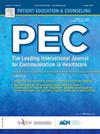COVID-19大流行期间烟草治疗方案中电话咨询与视频咨询的真实对比
IF 3.1
2区 医学
Q2 PUBLIC, ENVIRONMENTAL & OCCUPATIONAL HEALTH
引用次数: 0
摘要
目的:除了增加发病率和死亡率外,癌症诊断后继续吸烟还会增加癌症复发的风险、不良副作用以及一线治疗的有效性降低。结合咨询和美国食品和药物管理局批准的药物治疗是治疗烟草使用障碍(TUD)的最佳做法。2019冠状病毒病大流行带来了通过远程医疗平台提供护理的巨大转变。我们研究了通过电话和视频提供初步咨询是否会影响烟草治疗的效果,并确定可能选择这些方式的患者。方法为了应对大流行,MD安德森癌症中心的烟草研究和治疗项目(TRTP)将100% %的服务转移到完全远程远程医疗平台。由于疫情期间德克萨斯州政府暂停了面对面访问的要求,我们能够通过电话或视频提供初步咨询。数据收集于2020年5月1日至2021年4月30日,收集了参加TRTP综合项目的患者。患者选择了他们最熟悉的远程医疗方式。3、6、9个月的戒断率和治疗参与度(定义为参加咨询会议的总次数)在电话咨询组和视频咨询组之间进行了比较。结果电话组(N = 504)和视频组(N = 284)3、6、9个月的戒断率和治疗参与度相似。电话组的病人大多是白人和老年人。结论通过电话和视频进行初步咨询并不影响患者在随后的电话烟草治疗中实现戒烟的能力,也不影响患者的参与。实践意义这些结果确定了电话传递烟草治疗的有效性,包括为癌症患者提供药物治疗,并可为大流行后此类护理要求的政策提供信息。本文章由计算机程序翻译,如有差异,请以英文原文为准。
Real-world comparison of phone versus video consultation in a tobacco treatment program during the COVID-19 pandemic
Objective
In addition to increased morbidity and mortality, continued smoking after a cancer diagnosis results in the added risks of cancer recurrence, adverse side effects, and decreased effectiveness of first line treatments. Combining counseling and U.S. Food and Drug Administration–approved pharmacotherapy is best practice in the treatment of tobacco use disorder (TUD). The COVID-19 pandemic ushered in a dramatic shift toward provision of care through telehealth platforms. We examined whether providing an initial consultation by phone versus video impacted the efficacy of tobacco treatment and to identify patients likely to choose these modalities.
Methods
In response to the pandemic, MD Anderson Cancer Center's Tobacco Research and Treatment Program (TRTP) shifted 100 % of its services to fully remote telehealth platforms. Because requirements for a face-to-face visit were suspended by the Texas state government during the pandemic, we were able to provide the initial consultation by phone or video. Data were collected from 5/1/2020 through 4/30/2021 for patients enrolled in the comprehensive program of the TRTP. Patients selected the telehealth modality they were most comfortable with. Abstinence rates at 3, 6, and 9 months and treatment engagement, defined as total number of counseling sessions attended, were compared between the groups with phone versus video consultations.
Results
Abstinence rates at 3, 6, and 9 months and treatment engagement were similar in the phone (N = 504) and video (N = 284) groups. Patients in the phone group were more likely to be White and older.
Conclusion
Initial consultation via phone versus video did not affect patients’ ability to achieve abstinence during subsequent phone-based tobacco treatment and did not affect patients’ engagement.
Practice Implications
These results establish the efficacy of phone-delivered tobacco treatment, including the provision of medication for patients with cancer, and can inform policy regarding requirements for such care after the pandemic.
求助全文
通过发布文献求助,成功后即可免费获取论文全文。
去求助
来源期刊

Patient Education and Counseling
医学-公共卫生、环境卫生与职业卫生
CiteScore
5.60
自引率
11.40%
发文量
384
审稿时长
46 days
期刊介绍:
Patient Education and Counseling is an interdisciplinary, international journal for patient education and health promotion researchers, managers and clinicians. The journal seeks to explore and elucidate the educational, counseling and communication models in health care. Its aim is to provide a forum for fundamental as well as applied research, and to promote the study of organizational issues involved with the delivery of patient education, counseling, health promotion services and training models in improving communication between providers and patients.
 求助内容:
求助内容: 应助结果提醒方式:
应助结果提醒方式:


